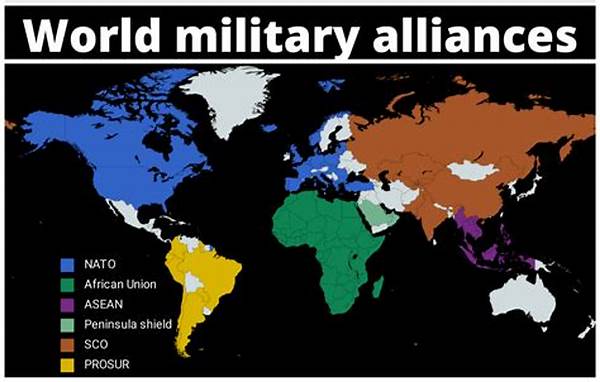Military alliance strategies play a significant role in maintaining global security and stability. Over the centuries, states have come together to form alliances, driven by shared interests, common threats, and mutual benefits. These alliances are formulated through complex strategies that involve diplomacy, military coordination, economic agreements, and more. Understanding these strategies is crucial for analyzing international relations and geopolitical dynamics.
The Importance of Military Alliance Strategies
Military alliance strategies are pivotal in shaping the power dynamics between nations. Such strategies not only provide a framework for mutual defense but also enhance diplomatic relations and economic cooperation among member states. Amid global uncertainties, alliances enable countries to pool resources, share intelligence, and increase their collective military capabilities, thereby deterring aggression from adversaries. These alliances often serve as a force multiplier, allowing member states to achieve greater strategic depth than they possibly could independently. Furthermore, they foster political stability by aligning countries with shared political ideologies and strategic goals, ensuring coordinated responses to international crises.
Militarily, alliances like NATO illustrate how collective security arrangements work to maintain peace and deter potential aggression. By establishing common defense policies and conducting joint military exercises, allied states are better prepared to respond to potential threats. Economically, military alliances can stimulate increased trade and technological cooperation, as allied nations often grant each other favorable trade terms. Thus, military alliance strategies are not only about defense but also about broader strategic objectives that affect the global balance of power. These multifaceted considerations highlight the complexity and importance of military alliance strategies.
Components of Effective Military Alliance Strategies
1. Shared Objectives: Military alliance strategies hinge on the alignment of mutual strategic goals. States must agree on primary defense objectives to ensure cohesion.
2. Communication Channels: Effective communication frameworks are crucial for the seamless execution of military alliance strategies. This involves regular dialogues and clear communication protocols.
3. Operational Coordination: Military alliances necessitate coordinated military operations and strategies, ensuring that all member states operate in unison to achieve common objectives.
4. Resource Allocation: Equitable distribution of resources among member nations is vital for effective military alliance strategies. This involves pooling and sharing military assets.
5. Crisis Response Mechanisms: Developing rapid response strategies to address emergencies ensures the resilience of military alliances under duress.
Historical Context of Military Alliance Strategies
Throughout history, military alliance strategies have shaped the geopolitical landscape. From the ancient alliances of Greek city-states to the grand coalitions of the World Wars, alliances have continuously evolved to suit the needs of the times. These strategies were often anchored in mutual defense pacts, where nations agreed to protect each other against external threats. As the global political environment shifted, so too did the nature and scope of these alliances, increasingly involving economic and technological cooperation.
In the 20th century, military alliance strategies were marked by the formation of large-scale multilateral organizations such as NATO and the Warsaw Pact. These alliances formed cohesive blocks in the bipolar world order, crystallizing Cold War politics. Military alliance strategies during this period focused heavily on deterring nuclear conflict and mitigating ideological encroachments. With the end of the Cold War, military alliance strategies have had to adapt to new global challenges such as terrorism and cyber threats, reflecting the dynamic and ever-changing nature of global security concerns.
Modern Military Alliance Strategies in Practice
Modern military alliance strategies emphasize adaptability and resilience in the face of evolving global threats. Today’s alliances must contend with a myriad of challenges, including non-state actors, cyber warfare, and emerging technologies. These strategies require robust intelligence-sharing frameworks to counteract asymmetric threats. Moreover, military alliances must engage in comprehensive training and joint military exercises to maintain operational readiness.
Furthermore, modern military alliances increasingly focus on humanitarian assistance and disaster response, recognizing that military capacities must also address non-traditional security concerns. The scope of military alliance strategies has broadened to include peacekeeping missions, counter-terrorism operations, and anti-piracy measures. The complexity of modern alliances is further amplified by diverse political interests and varying levels of commitment among member states. Hence, maintaining unity and ensuring strategic consensus remain crucial components of contemporary military alliance strategies.
Challenges Facing Military Alliance Strategies
Military alliance strategies are fraught with challenges in today’s geopolitical climate. Diverging national interests among member states can lead to tension and undermine the efficacy of alliances. Achieving unanimity in decision-making is a formidable task in multilateral alliances where diverse political, economic, and cultural perspectives must be reconciled.
Additionally, external pressures such as global power shifts and emerging threats complicate the alignment of military alliance strategies. Technological advancements pose another challenge, as member states must harmonize their technological competencies to sustain interoperable military systems. The reliance on collective defense can also be a double-edged sword—while member states benefit from shared security assurances, they can also become over-reliant and hesitant to engage independently. In light of these challenges, strategies must evolve to uphold the relevance and effectiveness of military alliances.
Innovations in Military Alliance Strategies
In recent years, innovations in military alliance strategies have sought to address existing challenges and enhance alliance effectiveness. Advancements in technology have allowed for improved communication and coordination within coalitions. Cyber defense collaboration is a burgeoning focus area, ensuring that military alliances can effectively counteract digital threats. Furthermore, alliances are increasingly adopting a flexible architecture, where partnerships can expand and incorporate new countries or focus areas in response to shifting global priorities.
The inclusion of non-traditional domains such as space and cyberspace into military alliance strategies exemplifies the multifaceted approach needed to address contemporary threats. Emphasis on value-sharing and cultural exchanges fosters unity and trust among member nations, thereby reinforcing the alliance’s strategic coherence. Such innovations point towards a future where military alliance strategies are more interconnected, agile, and responsive to global security needs.
Summary of Military Alliance Strategies
The examination of military alliance strategies reveals their indispensable role in maintaining international order and stabilizing geopolitical landscapes. By fostering collaboration, sharing resources, and establishing mutual defense mechanisms, military alliances effectively deter conflict and enhance security. Through a combination of shared objectives, strategic coordination, and flexible administrative frameworks, these alliances adapt to evolving threats and geopolitical shifts.
Military alliance strategies are increasingly oriented towards comprehensive security approaches, encompassing military defense as well as economic, technological, and humanitarian considerations. Recognizing the multifaceted nature of global security, modern alliances incorporate innovations in cyber defense, space exploration, and artificial intelligence, ensuring robust and resilient partnerships. Military alliance strategies ultimately underscore the importance of cooperation in navigating the complexities of international relations and ensuring peace and stability across regions.





